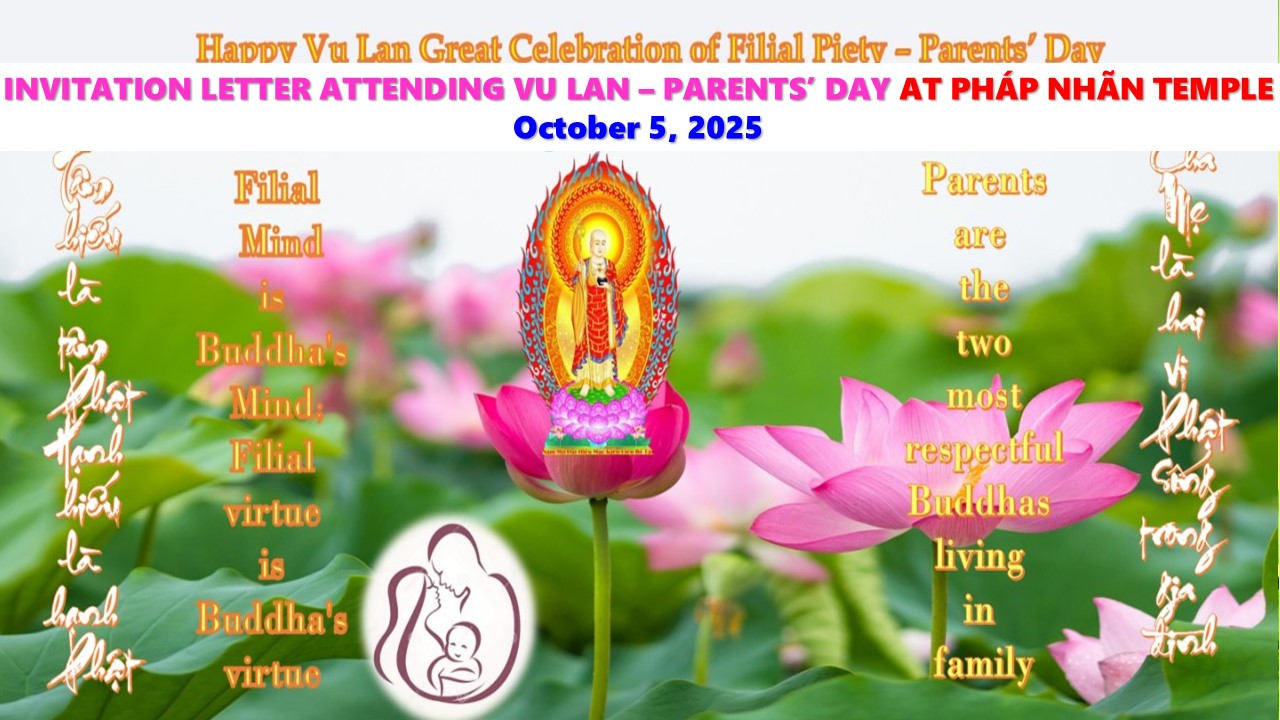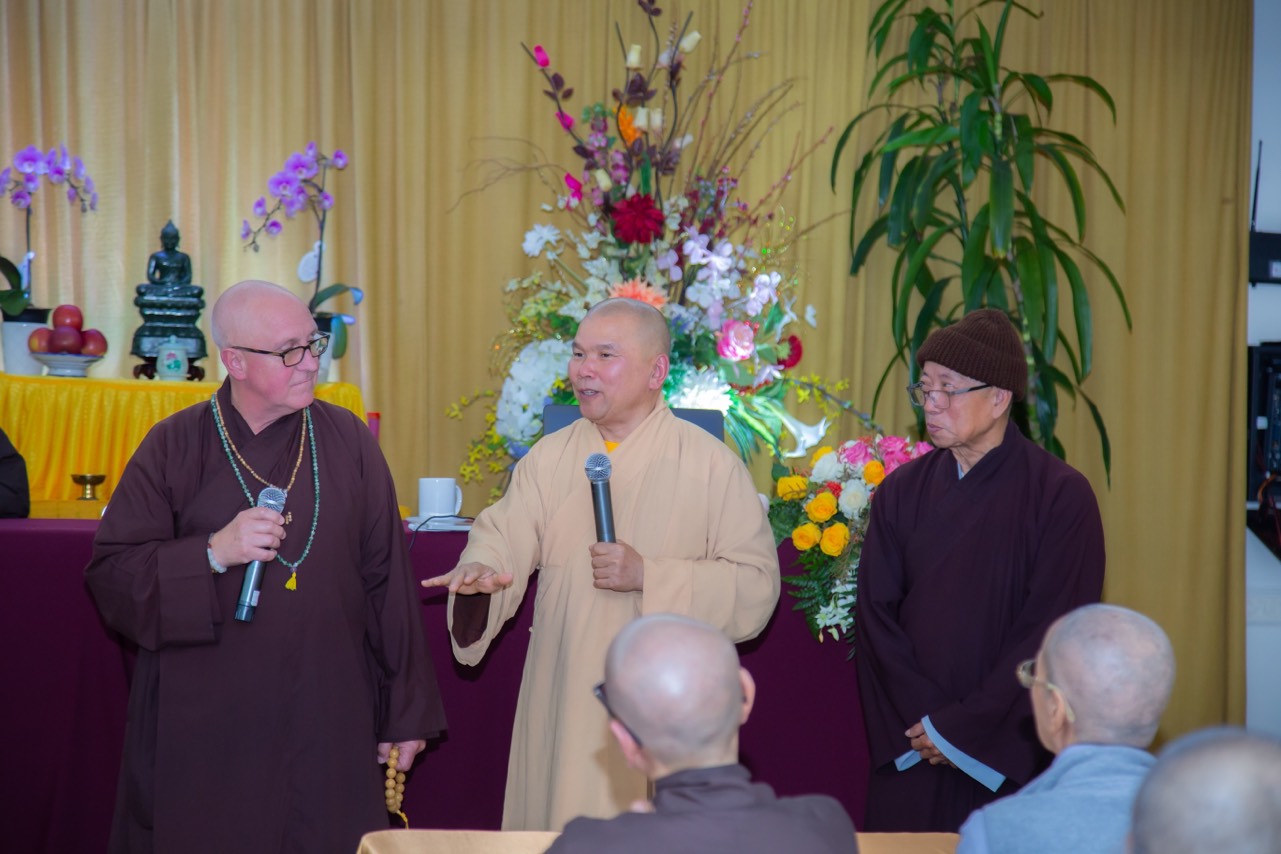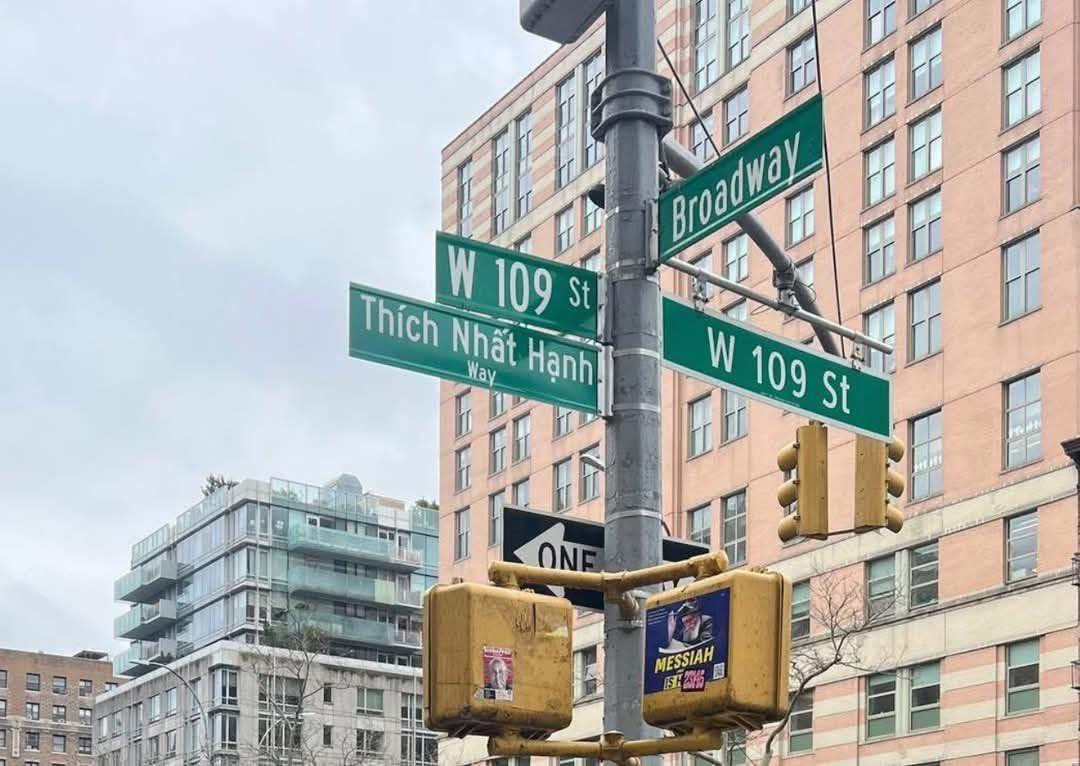
TRANQUILLY DWELLING TRADITION IN BUDDHISM
The Tranquilly Dwelling (Summer / Rains Retreats – Vassa Vassa) which is a beautiful feature, a specifically traditional feature of Buddhism has been present in India for more than thousands of years. The Tranquilly Dwelling is a good, favorable, and appropriate opportunity for the World-Honored One’s disciples to meet together, to cultivate virtuous precepts, to improve pious behavior, to build brother/sisterhood, the sentiment of Dharma friends cultivating together in the spirits of collectivity, harmony, solidarity, interdependence, mutual affection, mutual love, and mutual respect, according to the right path of Virtue, Concentration, and Wisdom.
At first, the Tranquilly Dwelling was a general custom and tradition for monastics and hermits of the various sects and religions in ancient India. Later, the Tranquilly Dwelling was skillfully received, adopted, maintained, upheld, developed, applied, and practiced by the Buddha and His disciples in accordance with the Buddhadharma from that time to now.
An Cư (Tranquilly Dwelling) is a compound word of Sino-Vietnamese; the literal sense of An means tranquility, quietness, stop, etc., and the figurative sense of the An means to gather together, to attend, to be present, etc.; The word Cư means place, dwelling, abode, Temple, Center of cultivation and learning, here and now, etc. Thus, An Cư means that practitioners gather together at many various Temples in different localities and countries in the spirits of diligence, peacefulness, harmony, and solidarity in order to exchange, to share the experience of cultivation, and to enjoy Dharma learning, Dharma talk, Dharma practice, Dharma joy, etc.
Looking at the various aspects of Buddhist history stretching back nearly three thousand years, we can learn more about the reason that Tranquilly Dwelling was adopted and purified by the World-Honored One and His disciples:
After the Buddha had attained perfect enlightenment under the Bodhi tree, and after He had been entreated three times by Brahma Sahampati[1] to remain in the world in order to teach the Buddha Dharma to human beings. The Buddha agreed to accept Brahma’s requests, and started the first turning of the Dharma Wheel in the Deer Park at Sarnath. Initially, the Buddha taught the five brothers of the Honored Elder Aññā Kondañña to make His disciples.[2] After that, Dasa, whose family, friends, etc. were also taught by the Buddha, became His disciples by reading out three Refuges: Taking refuge in the Buddha, taking refuge in the Dharma, and taking refuge in the Sangha.[3] With the energies of His cultivation, loving-kindness, compassion and wisdom, majesty and prestige, the Buddha accepted and taught many different kinds of people irrespective of caste, religion, color, and race.
However, when the disciples of the Buddha became more and more numerous, within the Sangha there were several un-virtuous followers, especially a group of six monks, who, thinking, talking, and acting lack of mindfulness and awareness, went out on a road and stepped on insects in spring, summer, and winter. At that time, Buddhists and non Buddhists disparaged their beharior and said: “Sramana Gautama’s disciples, who travel everywhere, step on insects, and do not have time to stop for a place to cultivate.”[4] When hearing this thing, the Lord Buddha taught His disciples to hold the Tranquilly Dwelling of the Summer or Rains Retreat (Vassa) every year according to the weather and climate in various regions and countries for suitability.
Indeed, the Tranquilly Dwelling of the Summer or Rains Retreat (Vassa) is the best opportunity for every practitioner to develop his or her inner mind, to practice Virtue, Concentration, and Wisdom, to build up the Sangha body, the Dharma body, and the Buddha body, to make the best merit field for lay Buddhists sow and plant.
According to the tradition of Mahayana Buddhism, time of the Tranquilly Dwelling of the Summer or Rains Retreat (Vassa) usually occurs after Vesak Week. Normally, it consists of three months, starting from April 16, and lasting to July 16 of the lunar calendar. According to the tradition of Theravada Buddhism, the Tranquilly Dwelling time also consists of three months, starting from June 16, and ending to September 16 of the lunar calendar.
However, in Western societies such as the United States of America, France, England, Germany, etc., according to different countries, residences, and localities, the Tranquilly Dwelling practitioners of Temples and of various Buddhist traditions are able to organize the Tranquilly Dwelling time for suitability.
For example, when the Tranquilly Dwelling Course opens the Summer or Rains Retreat (Vassa) on April 16, the tranquilly Dwelling practitioners must arrange to be present a day or so before, to rest and to recognize where to eat, where to stay, where to sleep, etc. in the residence where they attend the tranquilly Dwelling.
At the beginning of the Tranquilly Dwelling period, when gathering in a suitable residence of the Tranquilly Dwelling, practitioners have a joyous meeting to organize programs and times of cultivation and learning, such as Dharma teaching, precepts chanting, Sutras chanting, recitation of the Buddha’s names, walking meditation, sitting meditation, etc. At an early hour of the first Tranquilly Dwelling day, the Tranquilly Dwelling practitioners conduct a Ceremony, face to face with each other – face to face means that this person faces that person and reads the sincere inviting words of his or her cultivation and learning for every person to hear, to see, and to know how to instruct more, and vice versa, that person also practices it like this.
In the Tranquilly Dwelling residence, practitioners invite the Most Venerable Precepts Teaching Preceptor (Hòa thượng Thích Giáo Giới) to act as a Dharma Attorney demonstrating the Tranquilly Dwelling Ceremony. This Attorney relies on the Great Assembly to remind, to teach, and to advise, etc. When he has been chosen and invited by the Great Assembly, three Tranquilly Dwelling practitioners go to kneel down in front of him, one of three declares and says:
“Dear the Most Venerable Preceptor of the Precepts! Our Dharma names are Harmony, Peacefulness, and Stability. Today at this Temple, we have enough good opportunity to take refuge in the majesty and virtue of the Most Venerable in order to join together with the Great Assembly to cultivate, to learn, and to live together in a period of 10 days, 15 days, or 90 days, etc. During the whole time of the Tranquilly Dwelling, cultivation, and learning here, as Monastics, we are arranged according to the age of the precepts receiving, the Tranquilly Dwelling of the Summer or Rains Retreat (Vassa), and the merit of cultivation. Relying on the Dharma law, we receive accommodation, pillow, blanket, sleeping bag, our seat position to have a mindful and traditional lunch with the Great Assembly. We respectfully expect the Most Venerable to joyfully approve and allow us to express our sincere hearts!”[5]
Next, representing the Tranquilly Dwelling Assembly, a practitioner read out the boundaries of the Tranquilly Dwelling Temple such as the East counted as a house of Diligence; the South counted as that of Cultivation; the West counted as that of Application; and the North counted as that of Practice. When the boundaries are completely specified, in the process of attending the Tranquilly Dwelling, a practitioner has his or her individual mission, or mission of the Sangha, goes out of the Tranquilly Dwelling boundaries, he or she must say these inviting words in front of the Great Assembly:
Namo Original Master Sakyamuni Buddha
Dear the Most Venerable and Great Assembly, my Dharma name is Mindfulness, today I have a Buddhist activity, and must go out of the boundaries of the Tranquilly Dwelling Temple about an hour, half a day, or a day, etc. When completing the Buddhist activity, I turn back to the Tranquilly Dwelling residence, continue to take refuge in the Great Assembly to cultivate and to learn. Therefore, I respectfully expect the Most Venerable and the Great Assembly to happily approve my sincere speech!”[6]
In the Tranquilly Dwelling Course there is a Ceremony of Uposatha.[7] In this Ceremony, a practitioner is chosen by the Great Assembly to read the Dharma precepts, the remaining practitioners listen and review the Dharma precepts they have received. At the end of the Tranquilly Dwelling Course, there is a Ceremony of Tự Tứ (Pāli Pavāraṇā;[8] Chinese 钵和羅); in Chinese-Vietnamese transliteration word, Tự means I, myself, one, oneself; Tứ means invitation, illumination, or enlightenment. Thus, Tự Tứ means voluntariness, self-awareness, confession, and one invites the Tranquilly Dwelling practitioner to illuminate one’s strengths and weaknesses “seen, heard, and suspected” in the spirits of harmony and solidarity of the individual and the Great Assembly.
When one’s strengths are eulogized and praised, one tries to maintain, nurture, and develop them. Or, when one’s weaknesses are reminded and instructed, one accepts, corrects, transforms, and eliminates them step by step by doing penance by oneself and with the Great Assembly.
What is discussed above can be applied and practiced into the life of the Temple in every month once or twice. When monastics apply and practice the Buddha’s Dharma properly, they are not only happy, but their Master, Dharma brothers, and sisters are also happy. However, in the lives of family and couples, if parents, spouses, and children can apply and practice it well, each person becomes happy, his or her family and relatives also get happy.
Indeed, after finishing the Ceremony of Tự Tứ (Pavāraṇā), a representative of the Tranquilly Dwelling practitioners Assembly reads up the boundaries of the Tranquilly Dwelling Temple previously mentioned on the Tranquilly Dwelling first day, and says: “Today is the day of completion of the Tranquilly Dwelling Course of the Retreat; the boundaries of residence of this Tranquilly Dwelling Temple are opened and removed. The Tranquilly Dwelling practitioners may now go out of the Tranquilly Dwelling residence in accordance with the boundaries whose school of the Summer or Rains Retreat (Vassa) prescribed. Now, I would like to respectfully, clearly, and happily submit this to the Great Assembly.”[9]
When understanding, applying, and practicing like this, the practitioners can reap flowers and fruits of authentic peacefulness and happiness right here and right now in the present life. Thanks to the Tranquilly Dwelling of the Summer or Rains Retreat (Vassa), every practitioner has had one more stage to cultivate and merit to practice the Buddha Dharma by nurturing, beautifying, and developing the precepts of conduct, virtue of conduct, and piousness of conduct. The energies of cultivation, love, understanding, sympathy, forgiveness, tolerance, generosity, large-heartedness, peacefulness, and happiness of the Sangha have grown. The Buddhas, the Dharma guards, the good gods, and the Buddhists are very happy.
At this point, we learn more about the word Sangha; Sangha in Pāli means harmony and solidarity, mindfulness and awareness, steadiness and relaxation. Sangha means that a Congregation of cultivation consists of four or more people. Sangha includes two big Assemblies: the Assembly of monastics and that of lay people; the Assembly of monastics consists of Buddhist monks and nuns; that of lay people consists of lay men and lay women.
According to the Buddha’s teachings, in the Tranquilly Dwelling season of the Summer or Rains Retreat (Vassa), when the Assembly of monastics cultivate, learn the Dharma, and practice the Dharma, the Assembly of lay people also cultivate, learn the Dharma, and practice the Dharma, especially protect the Dharma. Taking refuge in a liberatingly brown robe and the peaceful image of the Sangha, in addition to learning Buddhism, understanding it, and practice the Dharma, the Assembly of lay people still develop their sincere hearts to protect Buddhism by offering the four things: 1. Robes or clothes, 2. Sleeping and resting things such as blankets, pillows, sleeping begs, etc. 3. Medications , and 4. Food and drink.
After the Tranquilly Dwelling Course of the summer or rains Retreat (Vassa) nearly finishes, to recreate and to look again at the tradition and the images of the Buddha’s and the Sangha’s begging for alms, the Assembly of monastics, that is, the Tranquilly Dwelling practitioners go for alms around the residence for the Assembly of lay people to have a good opportunity to nurture and to develop their devout hearts of giving alms and offering pure possessions and pure belongings for the residence and for the Tranquilly Dwelling practitioners.
When understanding and practicing those teachings like this, both the Assemblies of monastics and lay people travel together on the path of peacefulness, enlightenment, and freedom, and together bring authentic joyfulness and happiness to themselves and to others right in this world.
Thus, when completing the Tranquilly Dwelling Course of the annual Summer or Rains Retreat (Vassa), the Assembly of monastics have experienced one more stage of pious conduct, virtuous conduct, and wise conduct. Meanwhile, the Assembly of lay people also has acquired more merit, gratitude of virtue, and wisdom of virtue. Both of these Assemblies depend on and support one another like the image and its shadow, like water and its wave, and contribute together to bringing Buddhism into the future brightly and gloriously all over the world.
In attempting to present this writing concisely and briefly, the writer cannot avoid shortcomings, and respectfully expects the venerably honored Ones to be compassionate and joyously teaches him.
Finally, we would like to pray that the thankful blessings of the Triple Gem support and uphold you, monastics and lay people, Dharma protectors and Dharma preachers, along with all Buddhists, near and far in infinite peacefulness and infinite auspiciousness.
Namo the Original Master Sakyamuni Buddhaya
[1] See Connected Discourses (Saṃyutta Nikāya), the Section of Verses (Sagatha Vagga), 6. Brahma deities (samyutta – Brahma)
[2] See the Sutta of turning the Dharma Wheel (Dhammacakkappavattana Sutta) of Connected Discourses on the Truths (Samyutta Nikaya), 56: 11.
[3]http://www.daophatngaynay.com/vn/phat-phap/giao-phap/np-thp/11345-Giao-luu-Phat-phap-tt-.html
[4] See Luật Tứ Phần 4, Chương III, An Cư, trang 249-250. http://www.phatviet.com/thuvien/Q4_Tuphanluat_0506.pdf pp. 249
http://www.phatviet.com/dichthuat/luattang/yetmayc/ymyc6.HTM#_ftnref2
[5]http://www.phatviet.com/dichthuat/luattang/yetmayc/ymyc6.HTM#_ftnref2
[6] As the above mentioned web
[7] http://en.wikipedia.org/wiki/Uposatha,
http://www.accesstoinsight.org/ptf/dhamma/sila/uposatha.html
[8]http://www.ancient-buddhist-texts.net/English-Texts/Short-Pieces-in-English/Breathing.htm
[9] http://www.phatviet.com/thuvien/Q4_Tuphanluat_0506.pdf pp. 283.





















